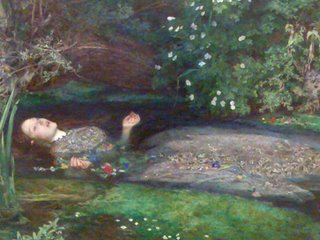Infused with Beauty

Many of you may be vaguely with this work - Millais' Ophelia. It's a prime attraction at the Tate Britain museum, which I visited today. Just a few years back, if one were to talk about visiting the Tate Gallery in London, one would have meant the current Tate Britain. Around the turn of the millennium, the Tate's extensive holdings of modern and contemporary international art were moved to the newly-opened Tate Modern down the Thames. The old gallery at Millbank was repositioned as the central showcase for British art from 1500 to the present.
I've never been to the Tate Britain before, and was glad to have made the journey today. Like another splendid attraction in the city, the Imperial War Museum, the Tate Britain lies just outside the tourist core of central London, with the nearest Tube station also a bit of a walk away. But that means you don't have to jostle for space with the thousands of other visitors, as you would often have to at the more well-known and centrally-located Tate Modern and the National Gallery. Instead, you have the chance to appreciate the artworks at your own pace, without hurry, without hassle, savouring what's on offer.
In generally quiet and well-designed galleries, the Tate Britain presents a chronological journey through the development of British art. That's where you would go to get a glimpse of great British artists such as Gainsborough, Constable, Sargent and, of course, the incomparable JMW Turner, who has an entire collection of his masterpieces on display.
One particular favourite of mine was the gallery introducing the works of the Pre-Raphaelites. This was the term used to denote the movement started in the mid-19th century by a group of British artists comprising John Everett Millais, Dante Gabriel Rossetti, William Holman Hunt and others. Rejecting the artistic conventions their time, the Pre-Raphaelites sought to hark back to a form of art and expression that was full of detail and focus, colour and, I would add, even beauty. Many turned to literature for sources of artistic inspiration.
Just look at Millais' portrayal of Ophelia, from Shakespeare's Hamlet. In the play, Ophelia was the daughter of Polonius, who was murdered by Hamlet. Utterly devastated, Ophelia slipped into a stream while collecting flowers and drowned. But her sanity had already departed earlier. The image I grabbed hardly does justice to the full richness of Millais' remarkable representation of Ophelia. A truly exquisite rendering, replete with such beauty in tragedy that one can only stand there, as I did, captivated, marveling at how subtly, how delicately even each strand and each stalk of nature was presented. It was truly, truly amazing.
As a post-script, I would add that Millais was certainly no one hit wonder. Right next to Ophelia, displayed in the same gallery, was this equally impressive image, also inspired by Shakespeare.

0 Comments:
Post a Comment
<< Home